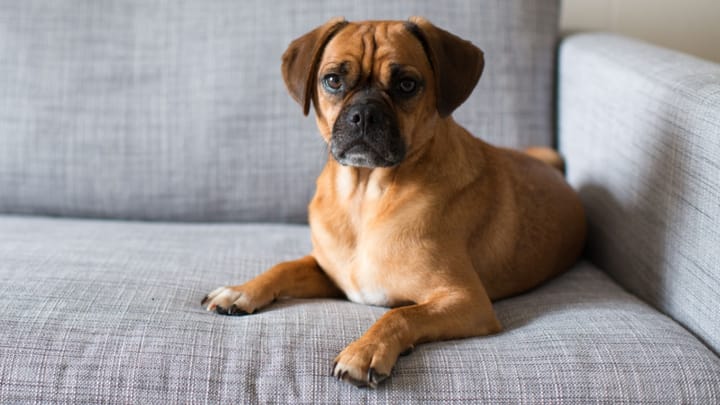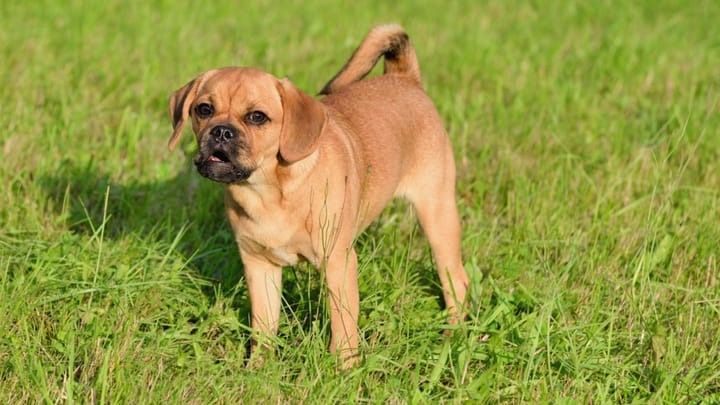Puggle


Pugs are small and friendly dogs with great characters. Playful, affectionate and sociable, they are very pleasant life companions, especially suited to life in a flat. These little dogs enjoy the comforts of life and need love and attention to thrive!
Beagles are medium sized hunting dogs (prone to chase small prey, with a special taste for hares). However, they are also perfect companions for dynamic owners who can fully meet their needs in terms of exercise and attention. Beagles are both intrepid and affectionate. And - fact - no-one can resist those drooping ears and those soft, sad and mischievous looks.

Pug
Pugs are small and friendly dogs with great characters. Playful, affectionate and sociable, they are very pleasant life companions, especially suited to life in a flat. These little dogs enjoy the comforts of life and need love and attention to thrive!

Beagle
Beagles are medium sized hunting dogs (prone to chase small prey, with a special taste for hares). However, they are also perfect companions for dynamic owners who can fully meet their needs in terms of exercise and attention. Beagles are both intrepid and affectionate. And - fact - no-one can resist those drooping ears and those soft, sad and mischievous looks.
|
Life expectancy |
The Puggle has a life expectancy of between 12 and 15 years |
|
Temperament |
|
|
Size |
Small
|
|
Adult size |
Female
Between 13 and 15 in
Male
Between 13 and 15 in
|
|
Adult weight |
Female
Between 18 and 29 lb
Male
Between 18 and 29 lb
|
|
Coat colour
|
Black Brown |
|
Type of coat
|
Short Hard |
|
Eye colour
|
Brown
|
|
Purchase price |
The Puggle costs between £500 and £1000 |
Celebrities have been spotted with Puggles over recent years, igniting interest in the crossbreed. According to The Happy Puppy website, celebrity Puggle owners include Kelly Osborne, Uma Thurman, Jake Gyllenhaal and even Sylvester Stallone.
More details about the Puggle
Puggle: Origins and history
In the 1980s , American breeder Wallace Havens deliberately crossed a female Beagle with a male Pug to create the Puggle. Similar cross-breeds may have occurred in the past by accident, but Havens is credited with creating the "breed." His goal was to combine the qualities of the Beagle and the Pug while avoiding their flaws, including the health problems of the Pug.
In the early 2000s, first generation puppies became available for sale and since then the Puggle's popularity has continued to grow, making it a highly sought-after cross.
To date, Puggle puppies have been born to one Beagle parent and one Pug parent. The breed will remain unregistered until Puggles have been successfully bred with other Puggles for several generations. However, Puggle x Puggle breeding has yet to be successful, which has prompted some veterinarians to warn of the medical complications associated with the breeding of brachycephalic breeds.
Puggle: Characteristics
Puggle: Behaviour
Training a Puggle
Puggles are intelligent, but they do have a stubborn side. Positive reinforcement techniques are recommended for best results.
Puggle: Lifestyle
Breed compatibility Puggle
Puggle: Purchase price
The Puggle is a very popular cross-breed at the moment, and as such unscrupulous breeders may try to sell dogs without prioritising their health and well-being. You should always ensure that you are working with a reputable breeder before purchasing a dog.
Puggle: Shedding
Average
Puggles shed moderately, but regular grooming is always recommended to keep their coat looking its best.
Puggle: Health
Puggles are generally robust, healthy dogs, who inherit a strong constitution from both the Pug and Beagle breeds.
The Puggle may have a longer muzzle than the Pug, but it can still have difficulty tolerating extreme heat. Precautions should be taken in hot weather to avoid respiratory problems.
Puggles generally tolerate the cold well.
Puggles can be big eaters, so they can be prone to putting on weight. A controlled diet and regular exercise are essential to avoid obesity.
Puggles can be prone to several common diseases inherited from their parent breeds. These include:
- Allergies, dermatitis, fungal infections (fungi): Puggles can suffer from a variety of skin conditions, so it is important to monitor their skin condition regularly and consult a veterinarian if symptoms occur.
- Conjunctivitis, eye inflammations: Puggles' eyes, inherited from the Pug, are prone to inflammation and infection. Regular cleaning is recommended to prevent these problems.
- Ear Infections: The floppy ears of the Puggle can make them more susceptible to ear infections. Regular ear cleaning is essential to prevent ear infections.
- Breathing problems due to nose shape: Although Puggles are less affected by brachycephalic syndrome than Pugs, some can still have breathing problems, especially in hot weather.
- Hip Dysplasia, Patellar Luxation: Puggles can inherit joint problems from Beagles and Pugs, requiring proper monitoring and care.
- Obesity






